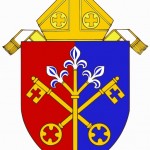
The Vatican has just announced plans for an unprecedented exhibit: For the first time ever, to mark the end of the Year of Faith, relics of St. Peter will be put on display for public veneration.
The exhibit was announced in L’Osservatore Romano by Archbishop Rino Fisichella, president of the Pontifical Council for Promoting New Evangelization. Archbishop Fisichella said that the veneration of the relics at the Vatican is a fitting way to conclude the Year of Faith November 24. Millions of pilgrims marked the Year of Faith by making a pilgrimage to St. Peter’s tomb. “The culminating sign” of the year, wrote Archbishop Fisichella, “will be the exposition for the first time of the relics traditionally recognized as those of the apostle who gave his life for the Lord here.”
But St. Peter died nearly 2,000 years ago! How can they really prove that those are Peter’s bones which lie deep beneath the great Basilica which bears his name?
* * * *

It was the Vatican’s art historian, Liz Lev, who first told me the story of the remarkable discovery of Peter’s bones. It’s a story which has been told often in history books and reports, but I draw some of my information from Paul of Tarsus: A Visionary Life by Edward Stourton.

The Church has had a long tradition that St. Peter’s Basilica, construction of which was funded by the Emperor Constantine, was built in the early fourth century atop the burial site of St. Peter. But in 1939–less than 100 years ago–a team of workmen digging a grave for Pope Pius XI in the crypt beneath the Basilica uncovered what was plainly the top of a Roman building. The new pope, Pius XII, ordered further investigation; and archeologists gradually unearthed a well preserved Roman necropolis, or city of the dead, immediately beneath the foundations of St. Peter’s.

In actuality, we don’t know with certainty whose bones those are. There are strong evidences through history: writings by early popes and kings, graffiti messages in the tomb, and the placement of the graves themselves. The early Christians, it seemed, considered it a great honor to be buried near the remains of Peter, the first pope. And DNA testing has confirmed that the bones are from a male in his 60’s who likely died in the first century.


Several years ago, I walked the hushed halls beneath the Basilica, and saw firsthand the ongoing excavations in the scavi. In the necropolis are sepulchres of wealthy Roman families which date back to the first and second centuries. The frescoed mausoleums bear clear images–colorful paintings, etchings, and mosaics. Graffiti on the walls seem to focus toward one burial site, believed to be that of St. Peter. On one graffiti wall, amid Christian symbols and petitions, the name of Peter is carved at least twenty times, usually accompanied by prayers for the dead person, and in one case expressing joy that the deceased relative lay in the same cemetery that held the body of St. Peter.
And here is the remarkable truth: If one were to drop a plumb line from the center of the Dome of the great St. Peter’s Basilica, 460 feet above, it would extend downward
- through Bernini’s baldacchino,
- through the Basilica’s great papal altar, then
- through the twelfth-century altar of St. Callistus.
It would continue downward,
- through the sixth century altar of Gregory the Great, then
- through the fourth century Constantine shrine.
Stretch that imaginary plumb line still farther and it would drop down
- to the second-century trophy (a kind of triumphal arch built to mark the burial place of great men), and finally,
- it would land upon the burial place of this great martyr of Christ, St. Peter.
“It doesn’t miss a foot,” writes Stourton.
“It is almost as if you can see that verse written in stone: ‘Upon this rock, I shall build My Church.’ From the very earliest days, St. Peter’s place at the center of the Church–figuratively and literally–has been fixed.”
* * * *
By the way, just what is a relic? Check out this older post for more information.











